Product Images Capecitabine
View Photos of Packaging, Labels & Appearance
Product Label Images
The following 11 images provide visual information about the product associated with Capecitabine NDC 59651-204 by Aurobindo Pharma Limited, such as packaging, labeling, and the appearance of the drug itself. This resource could be helpful for medical professionals, pharmacists, and patients seeking to verify medication information and ensure they have the correct product.
Metabolic Pathway of capecitabine to 5-FU - capecitabine fig1

This is a metabolic pathway for the drug capecitabine, which is converted to 5-FU through several steps that involve enzymes such as carboxylesterase and cyd deaminase. The pathway involves the conversion of capecitabine to 5'-DFCR, which is then converted to 5-DFUR and ultimately to 5-FU.*
PACKAGE LABEL-PRINCIPAL DISPLAY PANEL - 500 mg Blister Carton (1 x 10 Unit-dose) - capecitabine fig10
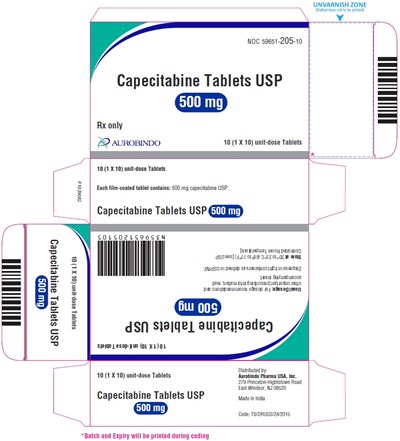
Figure 1 Kaplan-Meier Estimates of Disease-Free Survival (All Randomized Population) - capecitabine fig2
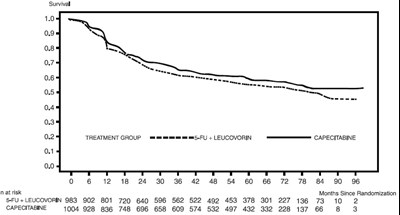
This is a survival analysis for two treatment groups, one receiving 5-FU + LEUCOVORIN and the other receiving CAPECITABINE. The table shows the number of patients at risk and the months since randomization for both groups. The data suggests that patients in the 5-FU + LEUCOVORIN group had a longer survival time compared to those in the CAPECITABINE group.*
Figure 2 Kaplan-Meier Estimates of Overall Survival (All Randomized Population) - capecitabine fig3

This seems to be a chart showing the survival rates for two different treatment groups over a span of 7 years, with the treatment options being 5-FU + LEUCOVORIN and CAPECITABINE. The chart is broken down into months since randomization and the number of participants still alive in each group is recorded for each time interval.*
Figure 3Kaplan-Meier Curve for Overall Survival of Pooled Data (Studies 1 and 2) - capecitabine fig4
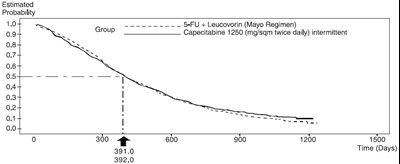
The text contains a table showing the estimated probabilities ranging from 1.0 to 0.0, and two chemotherapy treatments - 5-FU + Leucovorin and Capecitabine 1250 (mg/sqm twice daily) intermittent. There are also numerical values: 300, 400, 600, and 1500 in the text. The purpose or context of this information is not available.*
Figure 4 Kaplan-Meier Estimates for Time to Disease Progression Capecitabine and Docetaxel vs Docetaxel - capecitabine fig5
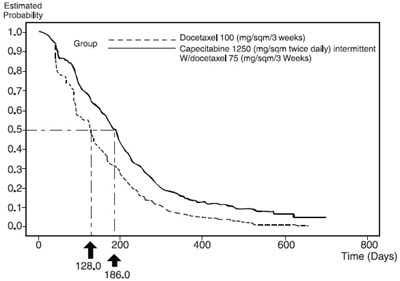
Figure 5 Kaplan-Meier Estimates of Survival Capecitabine and Docetaxel vs Docetaxel - capecitabine fig6
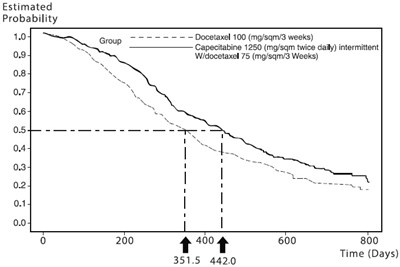
This appears to be a chart showing estimated probabilities related to the administration of various medications. The chart includes dosages for Docetaxel and Capecitabine, as well as the intervals for the administration of Widocetaxel. The two numbers listed at the top appear to be estimated probabilities, but without additional information or context, it is difficult to determine what they represent. The numbers along the bottom likely represent the length of time in days.*
PACKAGE LABEL.PRINCIPAL DISPLAY PANEL - 150 mg (60 Tablets Bottle) - capecitabine fig7
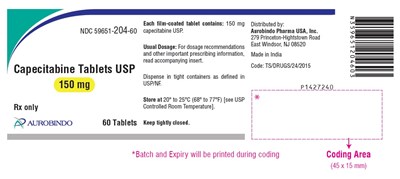
Each film-coated tablet contains: 150 mg of capecitabine USP. This medication is distributed by Aurahindo Pharma USA, Inc. and is available in a bottle of 60 tablets. It is recommended to store at 20° to 25°C (68° to 77°F) in tight containers. Capecitabine Tablets USP is used in cancer treatment and the dosage for the medication can be found in the accompanying insert. The batch and expiry date of the medication will be printed during coding.*
PACKAGE LABEL-PRINCIPAL DISPLAY PANEL - 150 mg Blister Carton (1 x 10 Unit-dose) - capecitabine fig8
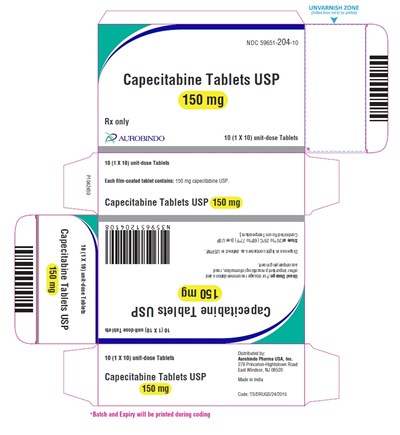
Capecitabine Tablets USP 150 mg is a prescription medicine with NDC 59651-204-10 and 10 (1X10) unit-dose tablets per bottle. The tablets contain 150 mg of capecitabine USP. The medicine is manufactured in India by an unknown company and distributed in the USA by Aurobindo Pharma USA, Inc. The batch number and expiry information are printed during coding. No other useful information is available from the output.*
PACKAGE LABEL-PRINCIPAL DISPLAY PANEL - 500 mg (120 Tablets Bottle) - capecitabine fig9
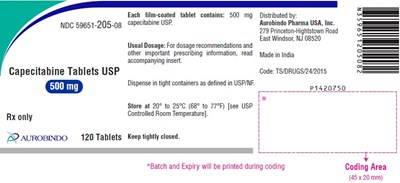
Each tablet contains 500mg of Capecitabine USP, distributed by Aurobindo Pharma USA, Inc. The recommended dosage can be found in the accompanying insert. As per USPINF, it should be dispensed in tight containers. Store at a controlled room temperature of 20° to 25°C. The batch and expiry details will be printed during coding. Contains 120 tablets.*
* The product label images have been analyzed using a combination of traditional computing and machine learning techniques. It should be noted that the descriptions provided may not be entirely accurate as they are experimental in nature. Use the information in this page at your own discretion and risk.
